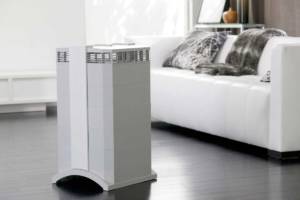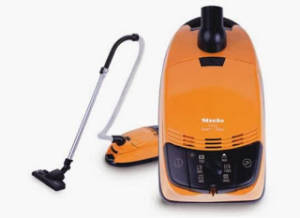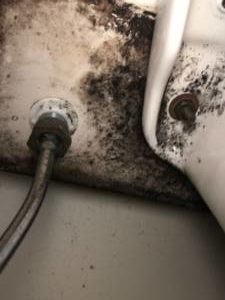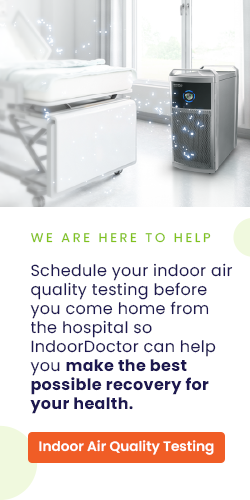Coming home from the hospital after an illness might seem like the worst is over, but could your indoor air quality be putting you at a greater risk than you realize? Whether you or a loved one has been hospitalized for sickness, minor surgery, childbirth, or even simple procedures or monitoring, poor air quality in your home could put you at further risk. Immune systems are in overdrive. Patients are more susceptible to illness when they come home from the hospital.

Proper precautions must be taken to avoid a revolving door of hospital visits. The environment each patient comes home to can either make for a smoother recovery or send you straight back to the doctor.
Identifying the Post-Hospital Syndrome
It’s not an official term, but “post-hospital syndrome” is described as a transient period of increased risk for illness after being hospitalized. It sounds counter-intuitive, especially since you sought hospital services in order to fight whatever was ailing you.
But the after-effects of being hospitalized could potentially lead to re-hospitalization.

What Causes Re-hospitalization?
Traditionally, re-hospitalization is thought to be caused by two things: the issue that resulted in hospitalization in the first place or a new illness or infection received while in the hospital.
However, medical experts say that being exposed to the stress of hospitalization can lead to vulnerabilities after the fact.
One study found that about one in five Medicare patients who were discharged were readmitted to the hospital within 30 days, with most reasons being unrelated to their initial hospital visit.
Experts point to the fact that stresses of the hospital can take many tolls on the body and mind. Patients aren’t sleeping as well as they should. Nutrition and physical activity aren’t optimal. Patients become deconditioned and their bodies’ immune system becomes compromised. Being depressed, lonely, or anxious can heighten these negative effects.
Is Indoor Air Quality Solely to Blame?
While it’s not accurate to say that poor indoor air quality is the only culprit behind rehospitalization, it’s easy to see how it can contribute to a patient’s health and recovery.
Modern homes are sealed more tightly than ever. It’s a great benefit to your energy bill, but not so much for your lungs. Because stale air is more easily trapped, the pollutants within the air also linger and grow.
Even for healthy people, long-term exposure to air pollutants can cause serious health issues.
The effects are multiplied for sensitive or weak immune systems. For someone who just got out of the hospital, air containing mold, bacteria, dust, allergens, chemicals, formaldehyde, ultrafine particulate matter, toxic gases, and other harmful toxins could slow recovery, cause infections, or otherwise ensure their trip home is short-lived.

How Indoor Air Quality Testing Can Benefit Recovering Patients
When you get out of the hospital, your initial reason for hospitalization isn’t your only worry. In addition to taking care of stitches, taking medications, making follow-up visits, or other post-hospital procedures, you must also be aware of outside forces that could worsen your condition.
Granted, you can’t control every risk that poses a danger to your health, which makes it all the more important to focus on the potential hazards you can control.
Indoor air quality testing will identify harmful contaminants in your home to see if your indoor environment may put your health at risk. Professional air quality testers use thorough procedures and the latest testing equipment to check for allergens, irritants, and other harmful components.
Using an independent expert like Indoor Doctor can help you get reliable, unbiased results regarding your indoor air quality. As a bonus, IAQ experts can also recommend potential courses of action to help you remedy any issues quickly and effectively.

Your Air Quality Prognosis Looks Grim: Now What?
If you opt for indoor air quality testing, what happens if the testing reveals a harmful level of contaminants?
Most patients can’t wait to go home from the hospital so they can sleep in their own beds surrounded by comforts. But the results from your IAQ testing may force to hold off on a happy homecoming.
Once test results reveal problems with your indoor air, there are a few things you can do to improve it quickly and mitigate its risky effects on health.
Give Your Home a Deep Clean
Start with detailed cleaning and maintenance before coming home from the hospital. Hiring a one-time cleaning service can help take the hassle and stress off you and ensure your home is spotless. Replace air filters on HVAC systems. Use a color-coded microfiber system to dedicated certain colored clothes for bathrooms and another color for eating areas.
Run a Medical Grade HEPA Air Purifier
Medical grade HEPA air purifiers, such as those offered by IQAir, are ideal for rooms of any size and work better than standard air purifiers. These machines eliminate mold, toxins, and other contaminants from the air, leaving fresh, pure air in its place.
Medical grade purifiers are powerful and effective. Treat your purchase as a medical necessity and a wellness tool.

Invest in Professional Carpet Cleaning
Professional carpet cleaners know the dangers of mold and other contaminants lurking in and under a carpet. They use specific techniques to mitigate the risk of contributing to mold growth to help you get the best possible results. This includes cleaning and drying carpets quickly to reduce moisture in the home and on the floor.
Carpet Cleaning When It’s Humid Can Lead to Toxic Mold
Upgrade Your Vacuum
Vacuum cleaners can be synonymous with dust creators. Every time you use a traditional vacuum, tiny particles disperse upward in your home atmosphere and contribute to poor indoor air quality. In essence, you believe you’re cleaning your home, but in reality, you’re transferring the dust from the floor to the air.
Switching to an allergy-friendly vacuum brand like Miele can keep dirt and dust where it belongs – inside the bag. Their high-efficiency filters seal in particles better than other vacuums, leaving you with better indoor air quality.
IndoorDoctor recommends the Miele Brand for their medical grade performance.

Sanitize All Surfaces
Use a quaternary disinfectant like Lysol on all the surfaces in your home, especially under toilet fixtures and water prone areas. There are tons of places for germs to hide, so don’t be afraid to be thorough. Focus on areas that are hard to reach and vulnerable to contamination like under your toilet tank.

Inspect Your Basement for Mold
Even though your basement is below your living space, the mold inside it can affect your overall air quality. Ensure your basement is healthy free from toxic mold that can rise and impact the rest of your home. Indoor Doctor offers Certified Mold Investigations to help you uncover hidden issues.
Improve the Health of Your Basement in a Weekend! Five Tips.
Schedule Your Indoor Air Quality Test for a Healthier Recovery
IndoorDoctor is the best value for people who want to know that their home is as healthy as possible. Schedule your indoor air quality testing in advance of your discharge date. Let us help you make the best possible recovery for your health.







